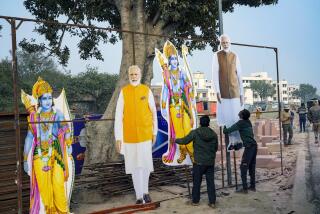A fire may have damaged precious relics at Tibet’s holiest temple. China says no — but experts aren’t sure

A fire broke out at Tibet’s most sacred temple on Saturday, and the public knows no more.
The blaze may have severely damaged the 1,300 year-old temple and many of its precious architectural features, murals and relics; or perhaps it was small and quickly extinguished, and the temple is more or less fine.
On Saturday evening, Tibetan social media users posted photos and videos of the ancient Jokhang Temple complex in the region’s capital Lhasa, a UNESCO world heritage site, with one of its golden roofs engulfed in flames. Hours later, Chinese state media said that the fire had been extinguished and that cultural relics were safe. No deaths have been reported.
Yet authorities since have restricted discussion of the fire on social media, leaving Tibetologists poring over shreds of dubious information to ascertain its most basic facts — how it started, how long it continued, how much damage it caused — and underscoring the Chinese government’s vice-like grip on information in Tibet, a minority region that has historically chafed against Beijing’s rule.
“There’s been this whole process of drip-feeding critical information to certain people, anonymously, unattributed,” said Robbie Barnett, a prominent Tibet expert based in London. “Key Tibetologists are getting this information; key foreigners in China are getting these accounts. But nobody outside knows where they’re from, and we don’t know which of the photos or stories are genuine.”
Jokhang, a crucial destination for Tibetan Buddhist pilgrims, is a sprawling compound of predominantly wood structures built in the 7th century. It lies at the center of Lhasa’s commercial core, surrounded by maze-like streets. Its main chapel is home to the Jowo, Tibet’s holiest statue, which is believed to be blessed by the Buddha himself.
Partly because of the temple’s importance and central location, it was the site of anti-Beijing demonstrations in the late 1980s. Security is reportedly tight.
On Thursday, China’s official New China News Agency reported that arson has been ruled out, that the temple’s roof has been removed “in case of collapse or reburning” and that the Jowo statue, as well as “all the registered 6,510 cultural relics and the main building,” are intact. The fire affected an area of about 500 square feet, the News Agency said, and “the temple opened to the public as usual one day after the fire.”
Tibet ranks among the world’s most repressive places. Since protests racked the region in 2008, authorities have imposed an intensive surveillance network and lowered their tolerance for dissent. Any criticism of the government, independent news reporting and support for the spiritual leader Dalai Lama — who has lived in India since Chinese forces occupied the region in 1959 — can incur draconian punishment, including jail terms.
The Chinese government restricts access to Tibet for foreigners, making independent verification of the damage from the fire difficult.
Yet information about the temple — photos, videos, anonymous witness reports — has been trickling out, and Tibetologists say it’s cast doubt on the official narrative. They say the compound’s main chapel, the one holding the Jowo, is still closed.
Barnett, the Tibetologist, has meticulously documented the flow of information on his Twitter feed. On Saturday evening, he wrote, a slew of social media posts from Tibet showed a fire raging at the temple. But soon afterward, he tweeted, “messages by phone from Tibet” claimed that police threatened to punish anyone “distributing ‘rumors’ ” about the fire, and the posts abruptly stopped.
Afterward, Barnett and other Tibetologists received photos — many from unknown sources — that supported the government’s narrative. One showed the holy Jowo statue seemingly intact, with a yellow curtain behind it. Two satellite photos showed the temple from above, highlighting the main chapel, which they stated was intact.
Several reports were inconsistent, contradictory and, in some cases, possibly false. The photo of the intact Jowo was undated, its framing awkward; the yellow curtain was out of place, Barnett said, raising the possibility that it could be concealing further damage. A column next to the Jowo is typically inlaid with precious stones, but in the photo, it is bare. The satellite photos were wrongly marked.
“Whatever we make of the information management that has taken place — and whether we think it’s accurate or not — it’s been very effective in calming people outside Tibet because they believe what the Tibetan exile government is telling them,” Barnett continued. “But people in Tibet face all kinds of concerns because they know that nobody can get there, and nobody there can say anything — it’d be very dangerous to spread news. They are much less credulous than people outside, and much more concerned, from what I gather.”
Tibetan writer Tsering Woeser tweeted a leaked public security bureau report, which said that authorities were notified of the fire at 7:07 p.m. local time, 26 minutes after it began, revealing a delay in reporting the blaze. It said “37 fire vehicles and over 200 soldiers were deployed” almost immediately, putting the fire out at 8:05. It said the relics had been moved, ostensibly protecting them from the flames.
Amy Heller, a Tibet expert and art historian at the East Asian Civilizations Research Center in Paris, said that fire safety at Jokhang has posed a challenge to authorities for years. Traditionally, throughout the year, and especially during Tibetan new year celebrations, Tibetans offer thousands of butter lamps within the temple. In 2002, at the request of the Jokhang monks, the government built an external structure to hold the lamps — and while some Tibetan advocacy groups initially were alarmed by the move, they since have come to see it as a prudent fire prevention measure.
Yet she remained skeptical about official explanations and voiced concern about the Jowo statue’s condition. She noted that the official reported size of the fire is bigger than any of the individual chapels. “As for the matters of smoke damage, water damage, damage due to chemical products in fire extinguishers — we still know nothing,” she said.
The Tibetan government in exile in Dharamsala, India, also has expressed alarm at the lack of information about the fire.
“This has panicked the whole world,” said Sharling Tenzindadon, chief editor of the government in exile’s Department of Information and International Relations. “There’s no information except for two reports saying that the fire has been put out and the site has been reopened. That’s not enough.”
For more news from Asia, follow @JRKaiman on Twitter
More to Read
Start your day right
Sign up for Essential California for news, features and recommendations from the L.A. Times and beyond in your inbox six days a week.
You may occasionally receive promotional content from the Los Angeles Times.






